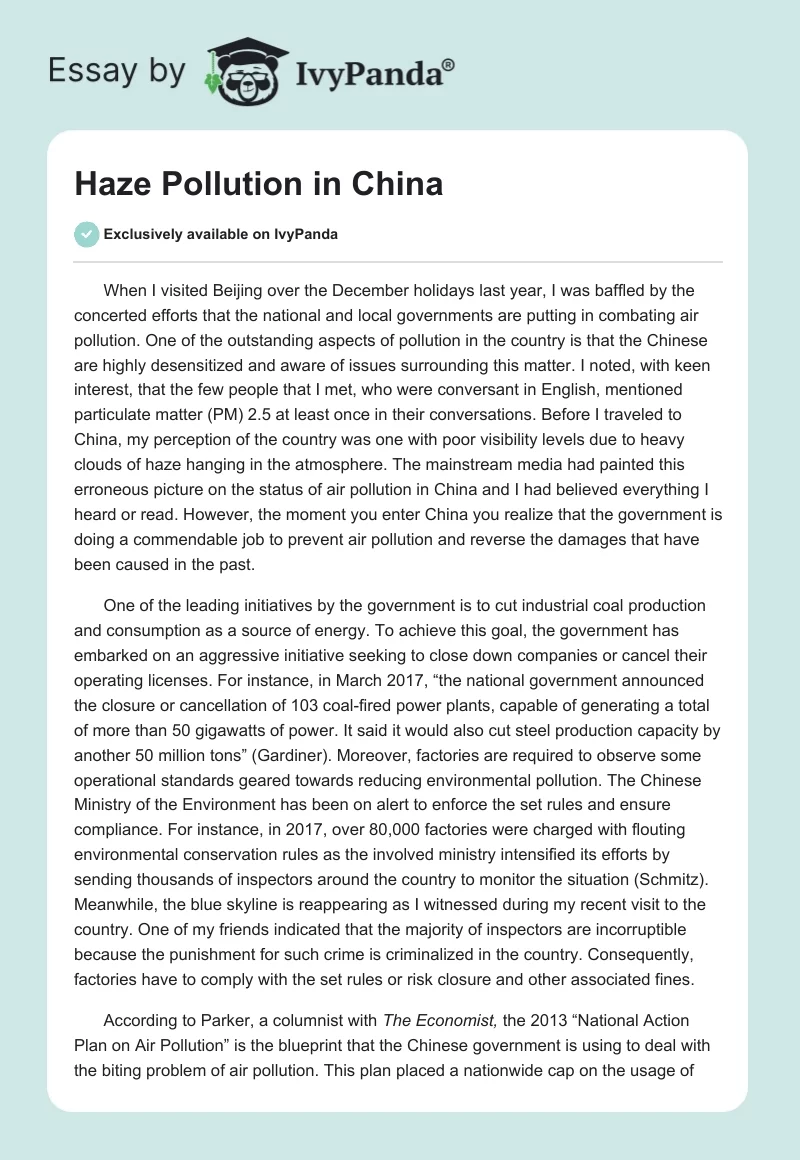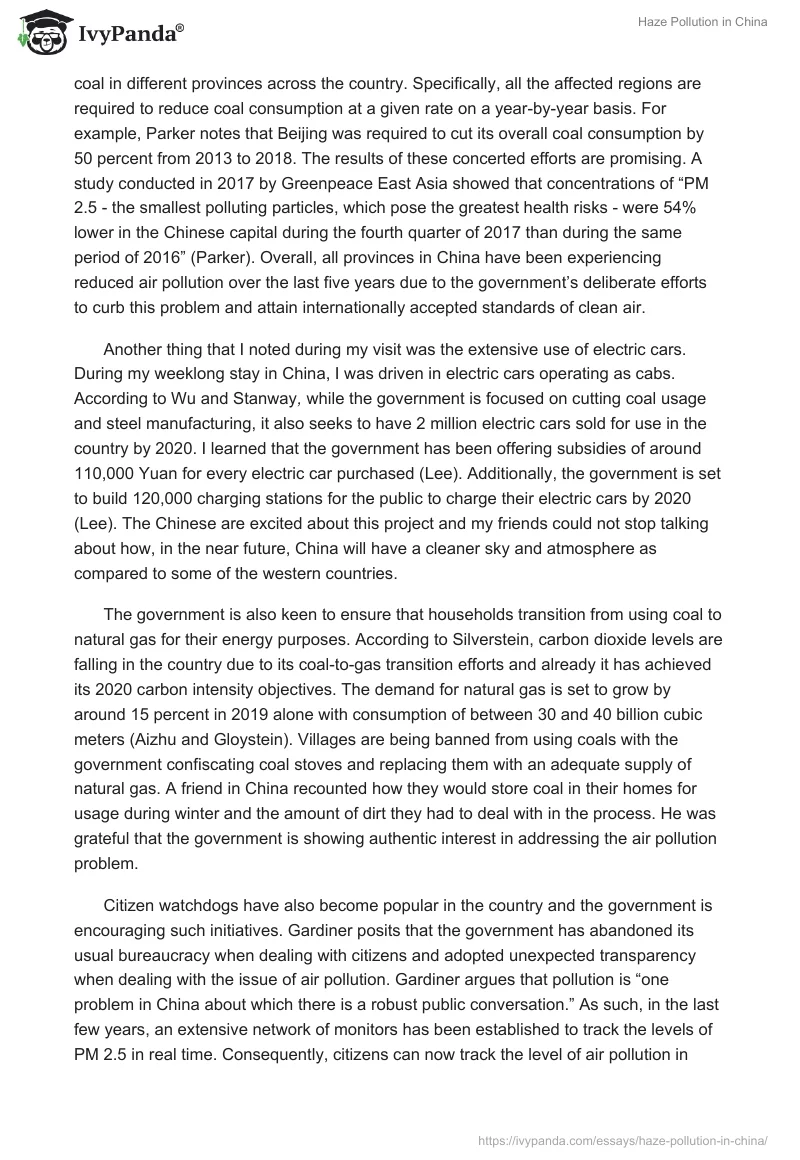When I visited Beijing over the December holidays last year, I was baffled by the concerted efforts that the national and local governments are putting in combating air pollution. One of the outstanding aspects of pollution in the country is that the Chinese are highly desensitized and aware of issues surrounding this matter. I noted, with keen interest, that the few people that I met, who were conversant in English, mentioned particulate matter (PM) 2.5 at least once in their conversations.
Before I traveled to China, my perception of the country was one with poor visibility levels due to heavy clouds of haze hanging in the atmosphere. The mainstream media had painted this erroneous picture on the status of air pollution in China and I had believed everything I heard or read. However, the moment you enter China you realize that the government is doing a commendable job to prevent air pollution and reverse the damages that have been caused in the past.
One of the leading initiatives by the government is to cut industrial coal production and consumption as a source of energy. To achieve this goal, the government has embarked on an aggressive initiative seeking to close down companies or cancel their operating licenses. For instance, in March 2017, “the national government announced the closure or cancellation of 103 coal-fired power plants, capable of generating a total of more than 50 gigawatts of power.
It said it would also cut steel production capacity by another 50 million tons” (Gardiner). Moreover, factories are required to observe some operational standards geared towards reducing environmental pollution. The Chinese Ministry of the Environment has been on alert to enforce the set rules and ensure compliance. For instance, in 2017, over 80,000 factories were charged with flouting environmental conservation rules as the involved ministry intensified its efforts by sending thousands of inspectors around the country to monitor the situation (Schmitz).
Meanwhile, the blue skyline is reappearing as I witnessed during my recent visit to the country. One of my friends indicated that the majority of inspectors are incorruptible because the punishment for such crime is criminalized in the country. Consequently, factories have to comply with the set rules or risk closure and other associated fines.
According to Parker, a columnist with The Economist, the 2013 “National Action Plan on Air Pollution” is the blueprint that the Chinese government is using to deal with the biting problem of air pollution. This plan placed a nationwide cap on the usage of coal in different provinces across the country. Specifically, all the affected regions are required to reduce coal consumption at a given rate on a year-by-year basis. For example, Parker notes that Beijing was required to cut its overall coal consumption by 50 percent from 2013 to 2018. The results of these concerted efforts are promising.
A study conducted in 2017 by Greenpeace East Asia showed that concentrations of “PM 2.5 – the smallest polluting particles, which pose the greatest health risks – were 54% lower in the Chinese capital during the fourth quarter of 2017 than during the same period of 2016” (Parker). Overall, all provinces in China have been experiencing reduced air pollution over the last five years due to the government’s deliberate efforts to curb this problem and attain internationally accepted standards of clean air.
Another thing that I noted during my visit was the extensive use of electric cars. During my weeklong stay in China, I was driven in electric cars operating as cabs. According to Wu and Stanway, while the government is focused on cutting coal usage and steel manufacturing, it also seeks to have 2 million electric cars sold for use in the country by 2020.
I learned that the government has been offering subsidies of around 110,000 Yuan for every electric car purchased (Lee). Additionally, the government is set to build 120,000 charging stations for the public to charge their electric cars by 2020 (Lee). The Chinese are excited about this project and my friends could not stop talking about how, in the near future, China will have a cleaner sky and atmosphere as compared to some of the western countries.
The government is also keen to ensure that households transition from using coal to natural gas for their energy purposes. According to Silverstein, carbon dioxide levels are falling in the country due to its coal-to-gas transition efforts and already it has achieved its 2020 carbon intensity objectives. The demand for natural gas is set to grow by around 15 percent in 2019 alone with consumption of between 30 and 40 billion cubic meters (Aizhu and Gloystein).
Villages are being banned from using coals with the government confiscating coal stoves and replacing them with an adequate supply of natural gas. A friend in China recounted how they would store coal in their homes for usage during winter and the amount of dirt they had to deal with in the process. He was grateful that the government is showing authentic interest in addressing the air pollution problem.
Citizen watchdogs have also become popular in the country and the government is encouraging such initiatives. Gardiner posits that the government has abandoned its usual bureaucracy when dealing with citizens and adopted unexpected transparency when dealing with the issue of air pollution. Gardiner argues that pollution is “one problem in China about which there is a robust public conversation.” As such, in the last few years, an extensive network of monitors has been established to track the levels of PM 2.5 in real time.
Consequently, citizens can now track the level of air pollution in different local areas using smartphones. In case facilities are found to be contravening the set regulations, citizens can report the same to the relevant authorities through social media. The Chinese government has been authoritarian and this change of governance style to engage citizens in decision-making and implementation of policies points to a regime committed to conserving the environment.
In conclusion, air pollution remains one of the major challenges facing China contemporarily as it struggles to balance economic growth and environmental conservation (Greenstone). However, the government is working strategically to address the problem of air pollution in the long term. While the mainstream media focuses on the challenge, a visit to the country will change the perception concerning the status of air pollution in China.
During my recent visit, it was clear that the government is managing the situation sustainably to the point of involving its citizens as watchdogs and key stakeholders in the country’s wellbeing and development. Some challenges are being experienced here and there, but the established strategies will ultimately yield positive results and, most probably, China will win the war against smog and haze pollution.
Works Cited
Aizhu, Chen, and Henning Gloystein. “China Gas Demand to Surge in 2019, but maybe not Enough to Sop Up LNG Glut.”Reuters. 2019, Web.
Gardiner, Beth. “China’s Surprising Solutions to Clear Killer Air.”National Geographic, 2017, Web.
Greenstone, Michael. “Four Years After Declaring War on Pollution, China Is Winning.”The Washington Post. 2018, Web.
Lee, Amanda. “China’s Electric Car Market is Growing Twice as Fast as the US. Here’s Why.”South China Morning Post. 2018, Web.
Parker, John. “How China Cuts its Air Pollution.”The Economist. 2018, Web.
Schmitz, Rob. “China Shuts Down Tens Of Thousands Of Factories In Unprecedented Pollution Crackdown.”NPR. 2017, Web.
Silverstein, Ken. “China is Swallowing a Bitter Pill and Trying to Cut Its Coal Use.”Forbes. 2018, Web.
Wu, Muyu, and David Stanway. “China to Cut Coal Use, Curb Steel in 2018-2020 Pollution Plan.”Reuters. 2018, Web.


